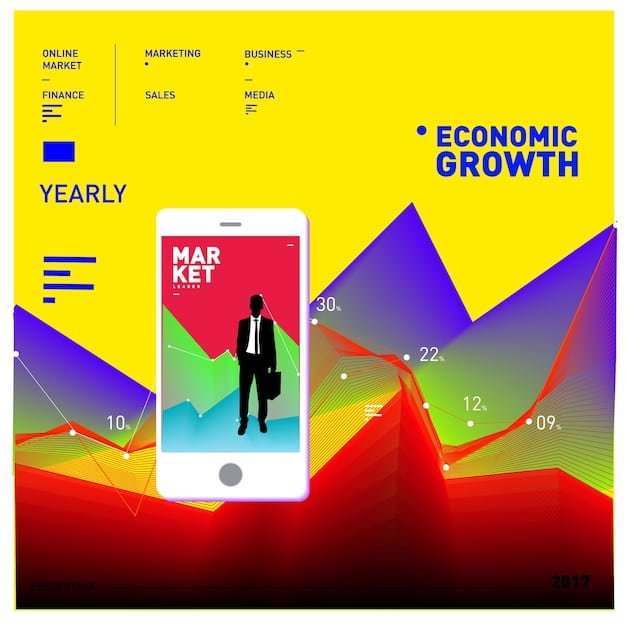The Power of Email Marketing: Strategies to Grow Your US Business

The Power of Email Marketing: Grow Your US Online Business with These Proven Strategies by leveraging targeted campaigns, personalized content, and data-driven analytics, to build customer relationships, drive sales, and boost brand awareness.
Unlock **the power of email marketing: grow your US online business with these proven strategies**. In today’s digital age, email marketing remains a cornerstone of effective online business growth, driving sales and building customer loyalty.
Understanding the Essence of Email Marketing for US Online Businesses
Email marketing is more than just sending out newsletters; it’s a strategic tool that, when wielded correctly, can significantly impact your online business’s growth in the US market. It allows businesses to connect directly with their target audience, providing personalized content that resonates with their needs and preferences.
For US online businesses, email marketing is a cost-effective way to engage customers, promote products, and drive sales. By understanding its core principles, businesses can leverage email to build stronger customer relationships and achieve sustainable growth.
Why Email Marketing Still Matters in the US
Despite the rise of social media and other digital marketing channels, email marketing remains incredibly relevant. It’s a direct and personal way to communicate with customers, ensuring that your message reaches them directly.
- Direct Communication: Email allows you to send personalized messages directly to individuals, improving engagement.
- Cost-Effective: Compared to other marketing channels, email marketing offers a high return on investment.
- Measurable Results: With email marketing tools, you can track opens, clicks, and conversions, allowing you to refine your strategies.
Email marketing’s ability to target specific customer segments and deliver personalized content makes it a powerful tool for driving conversions and building brand loyalty in the competitive US market.

Crafting a Winning Email Marketing Strategy for the US Market
A successful email marketing campaign starts with a well-defined strategy that considers your business goals and target audience. Understanding what you want to achieve and who you’re trying to reach is crucial for creating effective emails. Let’s explore some key components of a winning strategy.
Email marketing can achieve so many goals, but only with a solid strategy. It’s not just about sending emails; it’s about sending the right emails to the right people at the right time. A cohesive plan maximizes email efficiency.
Defining Your Target Audience
Knowing your audience is the foundation of any successful marketing effort. Understand their demographics, interests, and needs to tailor your email content effectively. Consider using buyer personas to visualize your ideal customers.
By deeply understanding their pain points, preferences, and online behaviors, you can craft email messages that resonate personally and drive higher conversions. Start with detailed audience research and segmentation.
Setting Clear Objectives
Determine what you want to achieve with your email marketing efforts. Are you looking to increase sales, generate leads, or improve customer engagement? Set specific, measurable, achievable, relevant, and time-bound (SMART) goals to guide your strategy.
- Increase Website Traffic: Drive more visitors to your website through strategic email promotions.
- Generate Leads: Capture new leads by offering valuable content or incentives in exchange for email sign-ups.
- Boost Sales: Promote products or services directly through targeted email campaigns.
Clarity in objectives enables focused email campaigns and better assessment of performance metrics. This also allows for strategic pivots when necessary, depending on market feedback.
Building Your Email List: Best Practices for US Businesses
Your email list is your most valuable asset in email marketing. Building a quality email list requires following best practices and ensuring compliance with US regulations, such as CAN-SPAM Act. Let’s delve into these best practices.
A thriving email list is more than just a collection of email addresses; it is a community of engaged recipients who are genuinely interested in your products or services. Building such a list requires ethical and strategic methods.
Ethical Opt-in Strategies
Always obtain explicit consent from individuals before adding them to your email list. Use opt-in forms on your website and offer incentives for signing up. Avoid purchasing email lists, as these often contain outdated or invalid addresses.
Double opt-ins further confirm consent by requiring new subscribers to confirm their subscription through an email link. This practice ensures a higher quality list of genuinely interested contacts.
Leveraging Lead Magnets
Offer valuable content or resources in exchange for email sign-ups. This could include e-books, whitepapers, webinars, or exclusive discounts. Ensure that your lead magnets are relevant to your target audience.
- E-books: Provide in-depth information on topics relevant to your industry.
- Webinars: Host online presentations or workshops to educate and engage your audience.
- Exclusive Discounts: Offer special promotions to incentivize sign-ups and drive sales.
By consistently delivering value through lead magnets, you can steadily grow your email list with qualified leads. This approach positions your business as a trusted resource in your niche.

Crafting High-Converting Email Content for Your US Audience
The content of your emails is crucial for engaging your audience and driving conversions. Crafting high-converting email content involves understanding your audience’s needs, writing compelling copy, and using effective design elements. Let’s explore how to create compelling email content.
The best email campaigns blend persuasive writing with visually appealing design. By striking this balance, businesses can capture attention and drive specific desired actions.
Personalization Techniques
Personalize your email content based on your subscribers’ demographics, interests, and purchase history. Use their names in the subject line and body of the email, and tailor content to match their preferences. Tools like dynamic content insertion can help you create highly personalized messages.
Personalization is no longer a luxury; it’s an expectation. By tailoring your emails to individual preferences, you can significantly increase engagement and conversions. Use data to inform your personalization strategy.
Compelling Subject Lines
Your subject line is the first impression. Make it concise, intriguing, and relevant to the email content. Use action-oriented language and create a sense of urgency or curiosity to encourage opens. Test different subject lines to see what resonates best with your audience.
- Urgency: “Limited Time Offer: 50% Off Ends Today!”
- Intrigue: “The Secret to Boosting Your Online Sales Revealed”
- Personalization: “[Name], Check Out These Exclusive Deals Just for You”
Subject lines should instantly convey the value of opening the email. A/B test several subject lines to identify which formulas drive the highest open rates. Optimize your subject lines for mobile devices, too.
Email Automation: Streamlining Your Marketing Efforts in the US
Email automation is a game-changer for US online businesses, allowing you to streamline your marketing efforts and deliver targeted messages at scale. By setting up automated email sequences, you can nurture leads, onboard new customers, and re-engage existing ones. Let’s explore how to harness the power of email automation.
Automation allows businesses to create personalized experiences at scale, improving customer engagement and driving conversions. Smart automation is like having a tireless marketing assistant available 24/7.
Setting Up Welcome Sequences
Create a series of automated emails to welcome new subscribers and introduce them to your brand. Share your company’s story, provide valuable content, and encourage them to explore your website or products. A well-crafted welcome sequence sets the tone for future interactions.
Welcome emails are crucial for making a positive first impression. They should educate new subscribers about your business, offer value, and encourage them to take action.
Triggered Email Campaigns
Set up triggered email campaigns based on specific actions or behaviors, such as abandoned carts, product views, or form submissions. These timely emails can help you recover lost sales, provide personalized recommendations, and improve customer satisfaction. If a customer puts an item in the cart, but doesn’t check out, it’s a perfect chance to engage.
- Abandoned Cart Emails: Remind customers about items left in their cart and offer incentives to complete their purchase.
- Product Recommendation Emails: Suggest products or services based on customers’ past purchases or browsing history.
- Re-engagement Emails: Reach out to inactive subscribers with special offers or exclusive content to re-engage them.
Automated emails are the backbone of an efficient marketing system, delivering relevant content at just the right moment. Monitor the performance of your automated campaigns to refine them continuously.
Measuring and Optimizing Your Email Marketing Performance in the US
Tracking and analyzing your email marketing metrics is essential for understanding what’s working and what’s not. By monitoring key performance indicators (KPIs) and optimizing your strategies accordingly, you can continuously improve your email marketing performance. Let’s explore how to measure and optimize your email marketing.
Data-driven decisions are the key to optimizing email marketing performance. By closely monitoring key metrics, businesses can identify areas for improvement and adjust their strategies accordingly.
Key Performance Indicators (KPIs)
Monitor metrics such as open rates, click-through rates (CTR), conversion rates, and bounce rates to gauge the effectiveness of your email campaigns. Use these insights to inform your optimization efforts.
Open rates reflect the appeal of your subject lines, while CTRs indicate the engagement of your email content. Conversion rates measure how effectively your emails are driving desired actions, such as purchases or sign-ups. Keeping all of these rates high increases business.
A/B Testing
Conduct A/B tests to experiment with different subject lines, email content, and call-to-actions. Test one element at a time to isolate the impact and identify the most effective strategies. You can only improve by measuring what’s failing.
- Subject Lines: Test different variations to see which ones generate the highest open rates.
- Email Content: Experiment with different layouts, images, and copy to optimize for engagement and conversion.
- Call-to-Actions: Try different wording, placement, and design elements to see which ones drive the most clicks.
Regular A/B testing ensures that your email marketing efforts remain optimized for maximum performance. The insights gained from these tests provide valuable guidance for continuous improvement.
| Key Point | Brief Description |
|---|---|
| 🎯 Targeted Campaigns | Reach specific customer segments with tailored messages. |
| ✍️ Personalized Content | Create emails that resonate with individual subscribers. |
| 📊 Data-Driven Analytics | Track metrics to optimize email performance. |
| 📧 Email Automation | Streamline your marketing efforts with automated sequences. |
FAQ
▼
Email marketing offers a direct, personalized way to connect with customers, build loyalty, and drive sales cost-effectively. It remains a highly effective channel for reaching target audiences, despite other emerging platforms.
▼
Obtain explicit consent through opt-in forms on your website. Offer valuable lead magnets like e-books or exclusive discounts in exchange for email sign-ups. Always avoid purchasing email lists to remain compliant.
▼
Personalize your content using subscriber data, craft compelling subject lines that create urgency or intrigue, and include clear calls-to-action. Use images or design elements that match the email content.
▼
Email automation lets you streamline marketing and deliver targeted messages at scale. Set up welcome sequences, trigger emails based on customer actions, and nurture leads. Automate your onboarding process.
▼
Track KPIs such as open rates, click-through rates, conversion rates, and bounce rates. Conduct A/B tests to experiment with different email elements. Regularly optimize based on observed patterns in the data.
Conclusion
Mastering **the power of email marketing: grow your US online business with these proven strategies** to connect, engage, and convert your audience. With a strategic approach, personalized content, and diligent optimization, email marketing stands as a potent tool for driving growth and achieving your business goals in the competitive US market.





